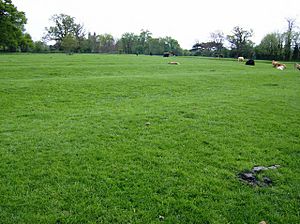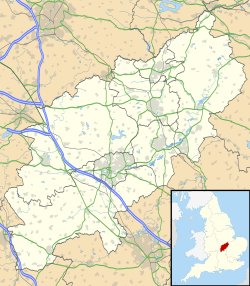Canons Ashby (lost settlement) facts for kids
Quick facts for kids
Deserted village of Canons Ashby
|
|
|---|---|
|
Lost Settlement
|
|

The site of the lost settlement of Canons Ashby
|
|
| Country | England |
| State | Northamptonshire |
| Region | East Midlands |
| District | Daventry |
| Municipality | Canons Ashby |
| Map Ref: SP576507 | |
The lost village of Canons Ashby is a place in Northamptonshire, England, that used to be a busy village but is now just open fields. It's located near Canons Ashby House. Today, a small village still exists around the house, but it's not in the same spot as the old one. The original village, once known as Ascebi, has completely disappeared. Now, cows graze where houses once stood!
Contents
The Story of Canons Ashby's Disappearance
This section tells you how the old village of Canons Ashby became a "lost" settlement. It's a fascinating look into medieval times.
Early Days of the Village
The village of Canons Ashby, then called Ascebi, is mentioned in the Domesday Book of 1086. This book was like a big survey ordered by William the Conqueror. It helped him know who owned what in England. Back then, only 16 people were recorded living in Ascebi.
In 1105, a special religious building called an Augustinian priory was built at the southern end of the village. A priory is a type of monastery where monks or nuns live. This priory soon owned most of the land around the village.
Growing and Shrinking
By 1301, 18 villagers paid a tax called the Lay Subsidy. This tax helped the King raise money for things like armies and ships. In 1316, the village was listed in the Nomina Villarum. This was a list of all towns and their lords, made for King Edward III.
The village seemed to be growing! By 1343, there were 41 houses in Canons Ashby. In 1377, 82 people paid the poll tax. This was a tax where everyone paid the same amount, no matter how rich or poor they were.
Why the Village Disappeared
Sadly, the village started to shrink. The leader of the nearby priory, called the prior, began to take over village land. He took about 100 acres (which is about 0.4 square kilometers) and even destroyed three houses. This meant people lost their homes and farms.
Things got worse. In 1492, the prior forced another 24 people out of their homes. By 1524, only 21 people were left to pay taxes. Just a few years later, in 1535, this number dropped to only nine!
The End of the Priory and Village
A big change happened in England called the Dissolution of the Monasteries. This was when King Henry VIII closed down many monasteries and priories. In 1537, the Canons Ashby priory and the village land were given to Sir Francis Bryon.
Sir Francis Bryon then sold the land to Sir John Cope a year later. It seems Sir John Cope didn't want a village there. Records show he had 2,000 sheep on the land! Sheep farming needed a lot of open space, which meant houses and villagers had to go. By 1674, tax records show only five families lived in the entire area. The old village was truly gone.
What's Left Today?
Even though the village is gone, you can still see signs of it! The old village site has amazing earthworks. These are bumps and hollows in the ground that show where buildings and streets used to be. They are in very good condition and show how big the village once was.
The main street of the old village followed the path of the lane that still goes past Canons Ashby House today. You can also see "hollow ways." These are sunken paths that were created by centuries of people and carts using the same route. They cross the main lane, showing where other village streets used to be.
To the east of these sunken paths, you can see raised areas. These are where old paddocks (small fields for animals) and platforms for former buildings once stood. If you look closely, you can almost imagine the layout of the old village. Over the years, people have found pieces of medieval pottery, called sherds, dating from the 13th and 14th centuries. These small finds help us learn more about the people who lived here long ago.


